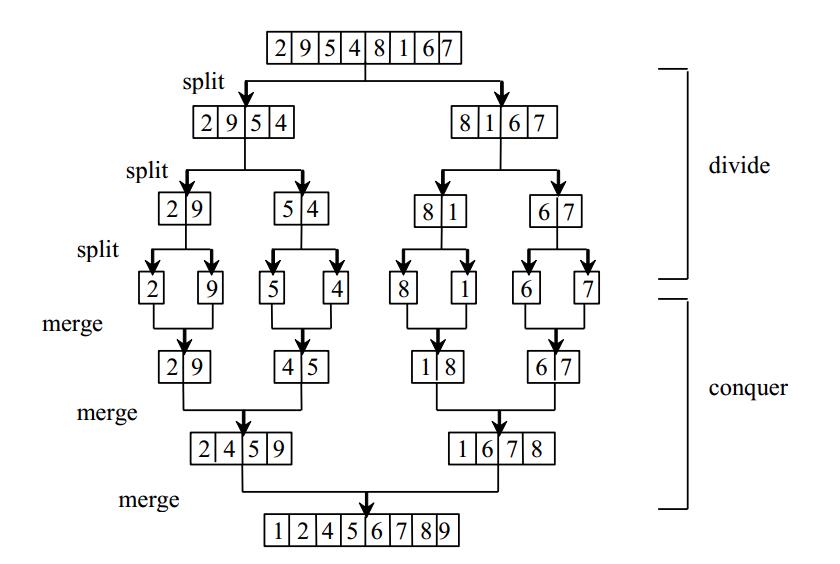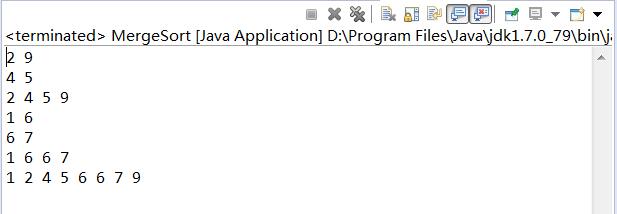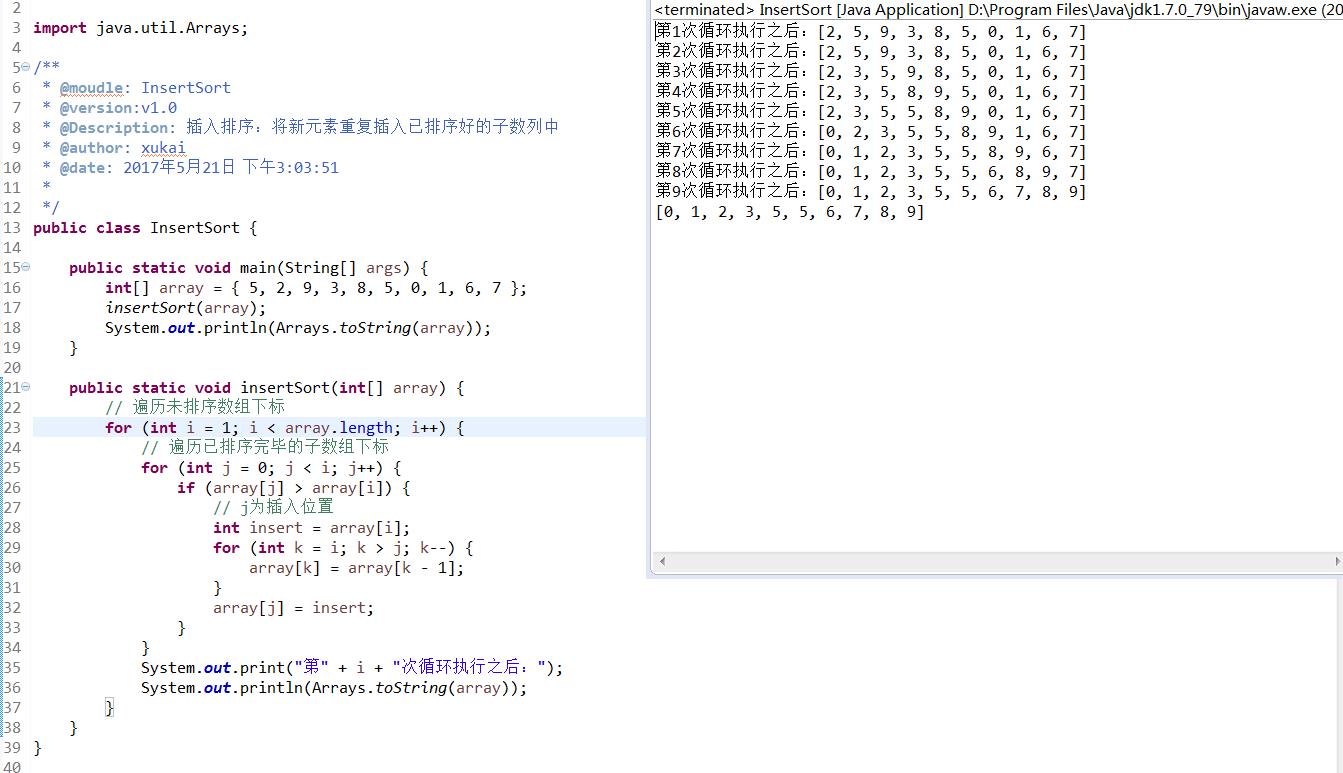排序——冒泡归并快速选择插入堆
Posted x_k
tags:
篇首语:本文由小常识网(cha138.com)小编为大家整理,主要介绍了排序——冒泡归并快速选择插入堆相关的知识,希望对你有一定的参考价值。
冒泡排序,O(n²)
原理:遍历集合多次,比较相邻的两个元素,将较大或者较小的元素向后移动,类似于“气泡”一样向上浮动。
/**
*
* <p>Title: 基础原理</p>
* <p>author : xukai</p>
* <p>date : 2017年5月16日 下午2:51:22</p>
* @param array
*/
public static void bubbleSort1(int[] array)
// 1.外层循环,次数为(length-1)
for (int i = 1; i < array.length; i++)
// 2.遍历集合,比较相邻元素大小
for (int j = 0; j < array.length - i; j++)
if (array[j] > array[j + 1])
swap(array, j, j + 1);
System.out.print("第" + i + "次循环执行之后:");
print(array);
优化:假如在外层循环中,某次循环一次都没有执行swap操作,说明集合已经排序完毕,无需再遍历
/**
*
* <p>Title: 某次遍历没有swap(排序完成),那么下一次也不需要遍历</p>
* <p>author : xukai</p>
* <p>date : 2017年5月16日 下午3:10:03</p>
* @param array
*/
private static void bubbleSort2(int[] array)
boolean needNextPass = true;
for (int i = 1; i < array.length && needNextPass; i++)
// 1.假设集合排序完毕
needNextPass = false;
for (int j = 0; j < array.length - i; j++)
if (array[j] > array[j + 1])
swap(array, j, j + 1);
// 2.假如未被执行,集合排序完毕,外层循环结束
needNextPass = true;
System.out.print("第" + i + "次循环执行之后:");
print(array);
归并排序,O(nlog(n))
原理:1.将集合平均拆分为两个子集合,对子集合进行归并排序。2.直到子集合中有且仅有一个元素,对两个子集合排序。

public class MergeSort
public static void main(String[] args)
int[] array = 2, 9, 5, 4, 1, 6, 7, 6 ;
mergeSort(array);
/**
*
* <p>Title: 1.递归拆除数组</p>
* <p>author : xukai</p>
* <p>date : 2017年5月17日 下午5:51:16</p>
* @param array
*/
public static void mergeSort(int[] array)
if (array.length > 1)
// 1.左侧数组
int[] arrayLeft = new int[array.length / 2];
System.arraycopy(array, 0, arrayLeft, 0, array.length / 2);
mergeSort(arrayLeft);
// 2.右侧数组
int arrayRightLength = array.length - arrayLeft.length;
int[] arrayRight = new int[arrayRightLength];
System.arraycopy(array, array.length / 2, arrayRight, 0, arrayRightLength);
mergeSort(arrayRight);
// 3.左右侧数组合并
int[] temp = merge(arrayLeft, arrayRight);
print(temp);
// 4.返回已经排序完毕的子数组
System.arraycopy(temp, 0, array, 0, temp.length);
else
return;
/**
*
* <p>Title: 合并两个数组</p>
* <p>author : xukai</p>
* <p>date : 2017年5月17日 下午5:51:33</p>
* @param arrayLeft
* @param arrayRight
* @return
*/
private static int[] merge(int[] arrayLeft, int[] arrayRight)
int[] temp = new int[arrayLeft.length + arrayRight.length];
int indexOfLeft = 0;
int indexOfRight = 0;
int indexOfTemp = 0;
while (indexOfLeft < arrayLeft.length && indexOfRight < arrayRight.length)
if (arrayLeft[indexOfLeft] < arrayRight[indexOfRight])
temp[indexOfTemp++] = arrayLeft[indexOfLeft++];
else
temp[indexOfTemp++] = arrayRight[indexOfRight++];
while (indexOfLeft < arrayLeft.length)
// 左侧未遍历完
temp[indexOfTemp++] = arrayLeft[indexOfLeft++];
while (indexOfRight < arrayRight.length)
// 右侧未遍历完
temp[indexOfTemp++] = arrayRight[indexOfRight++];
return temp;
private static void print(int[] array)
for (int i = 0; i < array.length; i++)
System.out.print(array[i] + " ");
System.out.print("\\n");
这里需要注意一点代码中的第4步,temp数组为已经排好序的数组,一定要复制给原数组

快速排序,O(nlog(n))
原理:任意选择主元元素(默认index=0),将数组分为两部分,左侧元素小于或等于主元,右侧元素大于主元。对左右两部分递归此操作。

/**
* @moudle: QuickSort
* @version:v1.0
* @Description: 快速排序:任意选择主元元素(默认index=0),将数组分为两部分,左侧元素小于或等于主元,右侧元素大于主元。递归此规则。
* @author: xukai
* @date: 2017年5月17日 下午6:21:08
*
*/
public class QuickSort
public static void main(String[] args)
int[] array = 5, 2, 9, 3, 8, 5, 0, 1, 6, 7 ;
quickSort(array);
print(array);
public static void quickSort(int[] array)
quickSort(array, 0, array.length - 1);
private static void quickSort(int[] array, int firstIndex, int lastIndex)
if (firstIndex < lastIndex)
int pivotIndex = partition(array, firstIndex, lastIndex);
quickSort(array, firstIndex, pivotIndex - 1);
quickSort(array, pivotIndex + 1, lastIndex);
/**
*
* <p>Title: partition</p>
* <p>author : xukai</p>
* <p>date : 2017年5月20日 上午11:39:50</p>
* @param array
* @param firstIndex
* @param lastIndex
* @return
*/
private static int partition(int[] array, int firstIndex, int lastIndex)
int pivot = array[firstIndex]; // 主元
int low = firstIndex + 1; // 向前下标
int high = lastIndex; // 向后下标
while (low < high)
// 当前元素小于等于主元,next
while (low <= high && array[low] <= pivot)
low++;
// 当前元素大于主元,prenext
while (high >= low && array[high] > pivot)
high--;
// low,high未移动,array[low]>pivot && array[high] <= pivot
if (low < high)
swap(array, low, high);
// TODO
/**
* case:
* 1.(array[high]==pivot)=true,next
* 2.lastIndex - firstIndex == 1
*/
while (high > firstIndex && array[high] >= pivot)
high--;
if (array[high] < pivot)
// pivot放在中间
array[firstIndex] = array[high];
array[high] = pivot;
return high; // 返回主元新下标
else
return firstIndex; // 主元下标
private static void print(int[] array)
for (int i = 0; i < array.length; i++)
System.out.print(array[i] + " ");
System.out.print("\\n");
private static void swap(int[] array, int i, int j)
int temp = array[i];
array[i] = array[j];
array[j] = temp;
***我一直没看懂代码中TODO标签下的while循环有什么作用,为什么不删除掉… ***
选择排序,O(n²)
原理:遍历数组,将最小的数放在最前面。遍历剩余元素,持续此操作。
/**
* @moudle: SelectSort
* @version:v1.0
* @Description: 选择排序:遍历数组,将最小的数放在最前面。遍历剩余元素,持续此操作。
* @author: xukai
* @date: 2017年5月21日 下午2:51:31
*
*/
public class SelectSort
public static void main(String[] args)
int[] array = 5, 2, 9, 3, 8, 5, 0, 1, 6, 7 ;
selectSort(array);
System.out.println(Arrays.toString(array));
public static void selectSort(int[] array)
// 遍历次数为length - 1;
for (int i = 0; i < array.length - 1; i++)
// 1.遍历数组找到min元素
int minIndex = i;
for (int j = i + 1; j < array.length; j++)
if (array[j] < array[minIndex])
minIndex = j;
// 2.swap(array[i],array[index])
if (minIndex != i)
int temp = array[minIndex];
array[minIndex] = array[i];
array[i] = temp;

插入排序,O(n²)
原理:将新元素重复插入已排序好的子数列中
public static void insertSort(int[] array)
// 遍历未排序数组下标
for (int i = 1; i < array.length; i++)
// 遍历已排序完毕的子数组下标
for (int j = 0; j < i; j++)
if (array[j] > array[i])
// j为插入位置
int insert = array[i];
for (int k = i; k > j; k--)
array[k] = array[k - 1];
array[j] = insert;
System.out.print("第" + i + "次循环执行之后:");
System.out.println(Arrays.toString(array));

堆排序,O(nlog(n))
堆特性:
- 一颗完整的二叉树(除了最后一层未满且叶子偏左,或每层都是满的)
- 每个结点大于或者等于它的子节点
添加结点原理:
- 将新元素放置进内部List集合
- 将新元素下标作为游标,开始遍历其父结点
- 如果大于父结点,swap(子节点,父结点),执行2和3,直到遍历树完毕。
删除结点原理:
- 判断是否为空树,if(true) return null
- 将最后的元素放置在index=0(根),并移除原先元素,temp=root
- 遍历树,游标从根开始,找到左右子树中最大值的下标maxIndex
- 比较游标和maxIndex的值大小,如果list(cursor)<maxIndex,那么swap
- cursor=maxIndex,依旧向下遍历树。直到无swap执行
import java.util.ArrayList;
/**
* @moudle: 堆类:1.每个结点大于它的所有子结点。2.完全二叉树
* @version:v1.0
* @Description: TODO
* @author: xukai
* @date: 2017年5月21日 下午1:58:16
*
* @param <E>
*/
public class Heap<E extends Comparable<E>>
private ArrayList<E> list = new ArrayList<>();
public Heap()
public Heap(E[] objects)
for (int i = 0; i < objects.length; i++)
add(objects[i]);
public void add(E object)
list.add(object);
// 1.新元素下标
int currentIndex = list.size() - 1;
while (currentIndex > 0)
int parentIndex = (currentIndex - 1) / 2; // 当前结点的父结点
// 2.新元素大于其父结点,swap
if (list.get(currentIndex).compareTo(list.get(parentIndex)) > 0)
E temp = list.get(currentIndex);
list.set(currentIndex, list.get(parentIndex));
list.set(parentIndex, temp);
else
break;
// 3.向上遍历树
currentIndex = parentIndex;
public E remove()
// 1.判断是否为空树,if(true) return null
if (list.size() == 0)
return null;
// 2.将最后的元素放置在index=0(根),并移除原先元素
E removeObject = list.get(0);
list.set(0, list.get(list.size() - 1));
list.remove(list.size() - 1);
// 3.从头遍历树
int currentIndex = 0;
while (currentIndex < list.size())
// 3.1 maxIndex(left,right)
int leftChildIndex = 2 * currentIndex + 1;
int rightChildIndex = leftChildIndex + 1;
if (leftChildIndex >= list.size())
break; // 超出范围
int maxIndex = leftChildIndex; // 默认为左子结点,右子节点可能为空
if (rightChildIndex < list.size())
if (list.get(maxIndex).compareTo(list.get(rightChildIndex)) < 0)
maxIndex = rightChildIndex;
// 3.2 if(current<maxIndex) swap(current, maxIndex)
if (list.get(currentIndex).compareTo(list.get(maxIndex)) < 0)
E temp = list.get(maxIndex);
list.set(maxIndex, list.get(currentIndex));
list.set(currentIndex, temp);
currentIndex = maxIndex;
else
break;
// 4.返回被删除元素
return removeObject;
public int getSize()
return list.size();
排序原理:执行堆的删除操作,即获得堆中最大值。
/**
* @moudle: HeapSort
* @version:v1.0
* @Description: 堆排序
* @author: xukai
* @date: 2017年5月21日 下午2:38:36
*
*/
public class HeapSort
public static void main(String[] args)
Integer[] array = 5, 2, 9, 3, 8, 5, 0, 1, 6, 7;
heapSort(array);
System.out.println(Arrays.toString(array));
public static Integer[] heapSort(Integer[] array)
// 1.创建一个堆对象,并初始化完毕
Heap<Integer> heap = new Heap<>(array);
// 2.反向遍历数组,从头开始删除
for (int i = array.length - 1; i >= 0; i--)
array[i] = heap.remove();
return array;
总结
JDK中有很多的排序方法实现,例如:Arrays里面的sort方法。
查看代码
动画演示
以上是关于排序——冒泡归并快速选择插入堆的主要内容,如果未能解决你的问题,请参考以下文章